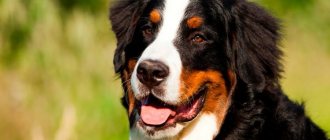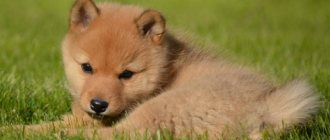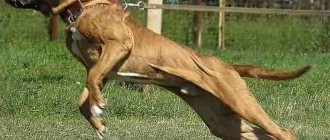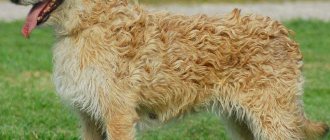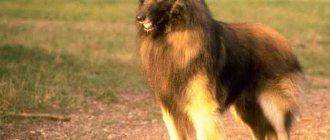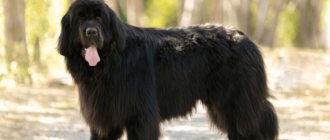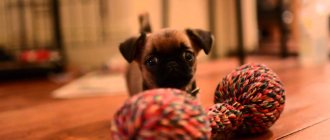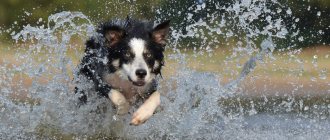History of the breed
The homeland of the Dogo Canario is Spain. To be precise, the origin of the breed occurred on the islands: Gran Canaria, Tenerife, and the Canary Archipelago. This is where the first part of the name “Canary” comes from.
The breed belongs to the herding and guard species. The purpose of the Presa Canario was to guard and herd livestock, and these powerful dogs were also used to participate in dog fights. The popularity of the Dogo Canario can be traced to:
- The sixteenth - seventeenth centuries - the peak of the population and popularity of the Canario as a herding and guard dog. This fact is recorded in official documents.
- The eighteenth – nineteenth centuries were the peak of the Great Dane’s popularity as a fighting dog and participant in dog fights.
- The mid-twentieth century saw a decline in popularity due to a reduction in the number of livestock, a ban on dog fighting and the ban on keeping the Dogo Canario, as an extremely dangerous dog in many countries.
The Moors, who at the beginning of our era, having arrived on an expedition to the Canary Islands, discovered huge dogs among the aborigine tribes, were amazed by their power and fearlessness. We are talking about the ancient ancestors of the modern Canario - the Mahorero herding dogs.
The Dogo Canario appeared as a result of crossing different breeds, each of which gave it certain qualities:
1. From majarero - brindle color. 2. From the Spanish mastiff - physique. 3. From the English mastiff - anger, high level of aggression.
Today, the Dogo Canario is used as a guard dog. In its homeland, the Canario is still a herding dog, successfully coping with cattle, including buffalo.
Breed standard
A standard was established in 1989.
Representatives of this species have a well-balanced physique and are quite large in size. Bitches have a longer body.
The height of adult individuals is 56-66 cm , weight is about 40-65 kg .
The neck is strong, relatively short with a skin dewlap. It holds a large head in the shape of a slightly elongated cube. The skull is slightly convex, the forehead area is flat. The ears in their natural form are not too large, drooping, while in the cropped form they are erect, with pointed tips.
The eyes are medium size, oval in shape. The color is dark, there are no Dogo Canarios with light eyes. Protruding or deep-set eyes are not acceptable. The eyelids are not drooping, dense.
The muzzle is shorter than the skull. Wide at the base, gradually tapering towards the nose. The nose is black and large in size. The nostrils are large and wide open.
The jaws are powerful and slightly protruding. A scissor bite is not a defect in a straight bite.
The back is straight. There is a slight rise from the withers to the croup. The muscles are well developed, but visually they are not very noticeable. The croup is wide, rounded. The chest is voluminous with clearly defined muscles. The belly is slightly tucked in.
The tail is thick and quite long. When calm, the Dogo Canario holds it hanging down, with a slight bend at the end. When excited, the dog raises its tail in the shape of a saber.
The limbs are straight, with wide bones and highly developed muscles. The paw pads are dark, the claws are strong. Fingers are rounded. The hind legs are longer than the front legs. The step is fast, elastic, long.
The skin hangs loosely in the neck area. The skin is elastic and thick.
The coat is short, the guard hairs are even. The Dogo Canario's coat is rough to the touch. There is no undercoat.
Colors allowed are brindle and fawn. Small white marks on the fingers and chest are not a fault. A dark mask on the face is required.
Description
This fighting dog looks terrifying: strong jaws reminiscent of ticks, a fierce and intent gaze, a powerful neck. And the height of the dog, reaching 64 cm at the withers, with a weight of 40-57 kg, makes you think carefully before placing this dog in the house. The dogs are very strong and large, athletically built, durable and reliable. On their massive body is an equally massive square-shaped head, which is covered with loose skin, giving the dog a wrinkled appearance.
The muzzle is also strong, wide, ending in a black nose. The oval, alert dark brown eyes are medium in size, and the ears are raised and resemble a rose petal. The paws are also powerful. The straight coat is coarse and short. It can be gray, brown, brindle, fawn or striped in color. Spots on the chest and neck are allowed. Despite its large size, the Dogo Canario is a fast and agile dog with excellent coordination and amazing grace.
Maintenance and care
Recommended conditions for keeping a Dogo Canary are a country house with a large garden plot. Such a dog feels great in an enclosure with a large booth or house. In winter, the booth should be heated.
The chain is completely unsuitable for Canarios. He is not comfortable in a small apartment in a city. Apartment housing is possible, but subject to a sufficiently large housing area, daily long walks and completion of a city obedience course.
Walking without a muzzle and leash is prohibited in public places. In order for the dog to be able to run freely, you need to find an opportunity to take your pet out into nature, to deserted places.
Caring for a short-haired Dogo Canario is not difficult at all. It is important to follow these procedures:
- We comb the wool 2 times a week.
- We bathe 2 times a year in warm weather. It is not recommended to overuse detergents so as not to disrupt the natural protective balance.
- We inspect the ears daily, clean them once a week, using pharmaceutical products recommended by the veterinarian.
- It is easier to clean your teeth with dogu by buying special bones. It is not easy to accustom him to toothpaste and brush.
- We trim the nails as they grow in with a nail clipper designed for large breeds.
A dog as large as the Presa Canario expends a lot of energy every day. She has a vital need for movement. Naturally, due to the large weight of the animal, the joints receive serious stress. For this reason, to avoid health problems, you need to carefully select your diet. Nutrition should help strengthen joints, ligaments and bones.
The diet should contain proteins, vitamins, and calcium. It is better to give preference to a natural method of feeding, especially for puppies and young Great Danes. If you decide to feed dry food, it should be premium. Don't forget to make sure that your canario has a sufficient amount of fresh, cool water in his drinking bowl around the clock.
Health
Take your pet to the veterinarian for regular checkups. Such visits will help keep the Dogo Canario’s health under control and begin timely treatment of detected diseases.
Representatives of the breed are not predisposed to serious hereditary diseases; they have strong immune defenses. But, like any living creature, pero de presa often has the following health problems:
- Epilepsy is a disease that cannot be cured, but it can be controlled by reducing the number of seizures accompanied by convulsions.
- Joint dysplasia is characterized by severe pain, sometimes unbearable. Without timely treatment, the dog may lose the ability to move.
- Entropion, eversion of the eyelid cannot be treated and requires surgical intervention.
- Scabies is a skin disease caused by mites.
- Diseases of the gastrointestinal tract - volvulus, bloating, diarrhea.
It is mandatory to get vaccinated on time. Deworming and treatment for skin parasites is also important.
Character
The Dogo Canario manifests itself as a calm, cautious, balanced, even somewhat phlegmatic dog. He treats household members in a friendly and noble manner. He is infinitely devoted to his owner, ready to defend him at the cost of his life, but in return he demands respect and attention. The owner of such a serious dog must be a strong-willed, strong person who knows how to handle large guard breeds.
He treats children from his family calmly and enjoys playing outdoor games. But you cannot leave a large dog alone with a child. The Great Dane will not tolerate children's pranks for long; he will try to leave or by grumbling or roaring he will warn that his patience has run out. It is better not to let other people's children near the pero de presa; he treats them like strangers, and is far from friendly.
With strangers he behaves arrogantly, distantly, suspiciously and even, one might say, aggressively. The Dogo Canary has a very highly developed guarding instinct. He will protect his territory at any cost.
Despite their fighting abilities, the Canarians are not inclined to be the first to start fights, but they will respond to a challenge with an incredibly powerful attack. Presa shows dominance towards other pets. He develops more friendly relationships with weaker animals and with dogs of the opposite sex.
For inappropriate behavior, unjustified aggression and unmotivated attacks on a person, first of all, one should blame not the Dogo Canary, but its owner, who failed to raise the dog, did not socialize it and did not take training courses with it.
Character of perro de presa canario
Canary dogs are classified as working breeds, but the standard does not require specific tests to check these qualities or test their psyche. By nature, the Presso de Canario resembles the Shar Pei, since they are the same phlegmatic people, but if necessary, for example, to protect the owner, they can amaze with their mobility and activity. The positive qualities of the breed are:
- equilibrium;
- endurance;
- unpretentiousness;
- confidence;
- independent decision making;
- high intellectual level;
- the ability to stand up for yourself and the owner.
Along with positive characteristics, Canary Mastiffs also have certain disadvantages that should be taken into account before purchasing a dog. Negative features are:
- stubbornness;
- dominance;
- distrust of strangers.
Temperament
Canarians are very affectionate and kind in the family circle, they get along well with children and give in to their pranks. In addition, dogs coexist peacefully with other pets. The breed is wary and distrustful of strangers. The dog's behavior will depend on the owners' reaction to strangers. Dogo Canarios are not characterized by unreasonable, sudden attacks of aggression: as a rule, they do not attack first and do not start a fight with other dogs. Since Canarios are distinguished by their independent, authoritative disposition, it is recommended to have one for people with a strong psyche and strong-willed character.
Relationships with a person
Canarians love to work, so they can serve as bodyguards, devoted companions, and watchmen. Despite their molossoid appearance, Great Danes move easily because they have a more compact build than the Caucasian Shepherd or St. Bernard. This indicates the dog’s ability to withstand long-term loads, and, if necessary, to be dexterous and mobile.
It is better to keep a dog of this breed for people who can show firmness in the process of raising and have experience in training animals. The protective qualities of the canario are manifested even in puppyhood, but the original purpose of the dog often causes difficulties in its upbringing. However, aggression on the part of Great Danes refers to such defects of the breed as unstable psyche.
Moderate viciousness is a quality inherent in Canarians, thanks to which they can defend themselves from the enemy. Because of this trait, people with mild temperaments and elderly people with health problems are not recommended to own a Dogo Canario. Dogs begin to guard a house or habitat at the age of several months, but the lack of undercoat does not allow them to survive on the street, so the dog can only be kept in a heated room.
Canary dogs take up little space in the house, are not annoying, and do not need constant attention from their owners. The animal sheds periodically, and its short hair can cause allergic reactions in members of the family in which it lives. With adequate upbringing and maintenance, the pet will not show intolerance towards children. The dog, as a rule, perceives other smaller pets as objects for protection.
Attitude towards strangers
Canarios treat strangers very carefully and with suspicion, but those who do not have bad intentions should not be afraid of the dog’s aggression: the animal will not attack or bite without good reason. The dog will probably just stay nearby and carefully observe the behavior of the stranger.
Canarians will also not bark loudly at guests, since they are silent. They voice only when there is a reason - this is how the guard instinct manifests itself. In dangerous situations, Dogo Canarios immediately attack.
Training and education
Dogo Canario must undergo obedience training courses for service dogs. It is not recommended to engage in training on your own, especially if you have no experience in this matter. The ideal option is training and education under the guidance of a dog handler.
Improper upbringing, as well as lack of training, will turn a canario into an uncontrollable, dangerous animal.
Representatives of the breed are difficult to train. They are prone to dominance, stubbornness, and willfulness. The basis of pres education is humility and obedience. The main thing is to become a leader for the Great Dane, a leader whose word is law.
It is worth noting that the mental abilities of Canarios are at the highest level. But the dog does not always direct them in the right direction. For example, a Great Dane often shirks classes and plays tricks, pretending to be tired. In such cases, it is important not to succumb to his tricks and achieve the execution of commands. Otherwise, such tricks will appear constantly in the future.
Interesting Facts
- In Australia and New Zealand, the import and possession of Pero de Presa Canario is prohibited.
- An attack by a Dogo Canario is absolutely hopeless for its opponent.
- The feeling of fear is unknown to the Canario, this dog is fearless.
- There are known cases of Canarian dogs attacking people with fatal results. For example, in Florida in 2006, a canario attacked its owner; the woman did not survive.
- The name "pero de presa canario" means "a dog with a powerful grip from the Canary Islands." This translation is explained as follows: “feather” in the translation “dog”, “presa” in the translation “to press”, “canario” - these are the Canary Islands.
Main characteristics
| Breed parameters | |
| Country of origin: | Canary Islands, Spain |
| Weight of the breed: | males: 45-64 kg, females: 39-54 kg |
| Height at withers: | males: 58-66 cm, females: 56-64 cm |
| Temperament: | calm |
| Wool: | short |
| Role in human life: | watchdog, fighting, companion |
The Presa Canario is a very rare breed of dog, endowed with incredible abilities. They get along well with children, take root in any territory, bark little and do not require complex care.
Pros and cons of the breed
Beginners and people with disabilities should not own a Dogo Canario. This pet is not recommended for families with small children. It is important to remember that the breed is on the list of the most dangerous dogs in the world.
Before buying a Pero de Presa puppy, familiarize yourself with its main pros and cons, then make a sound assessment of your strengths and capabilities.
Advantages:
1. Devotion. 2. Intelligence and intelligence. 3. Fearlessness. 4. Easy care. 5. Excellent guard and security qualities.
How to choose a puppy and its cost
Karantsev can rarely be found in the vast expanses of the former CIS. In the peripheries, there is practically no chance of getting into a nursery or an amateur breeding the breed. You can find advertisements for Dogo Canarios for sale on the Internet. Puppies are usually delivered to other cities. Buying a dog online makes it impossible to adequately inspect it. You can stumble upon a scammer, or buy a mongrel. If possible, you should read reviews about the breeder or nursery. If the city where the Great Dane is sold is nearby, it’s worth going to buy it yourself. This will allow you to examine the dog.
The cost depends on the class of the puppy, pedigree, and availability of documents. If you don’t have papers, you can buy a baby for between 7,000 and 10,000 rubles. If the breeder has all the documents and the dog’s pedigree, its cost will be at least 20,000 rubles. This is the price for puppies whose parents received a mediocre show grade. If they are top-class, winners of competitions and exhibitions, the purchase will cost at least 40,000 rubles. The maximum price for a puppy is 90,000 rubles.
According to the description of the Great Dane breed, it is better for them to be owned by people with experience in raising fighting breeds, living in a private house. If you keep your pet in an apartment, you will have to walk and play with it longer. With a lack of energy release, Canarians become aggressive and disobedient. The dog is not suitable for those who do not have time to train it.
Keeping a dog is quite expensive, you need to have a budget. Buying a Canarian in the CIS countries is problematic; searching for a genuine puppy will take time.
For those who decide to get a Great Dane, he will become a true friend for many years. It’s not worth parting with your pet for a long time. These fierce-looking four-legged friends have a hard time with separation and may refuse to eat or drink or get sick.
